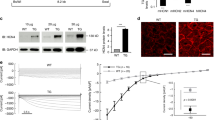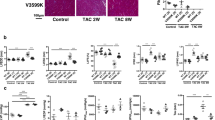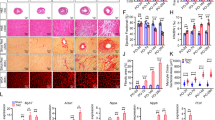Abstract
β-Adrenergic receptor (βAR) stimulation increases cytosolic Ca2+ to physiologically augment cardiac contraction, whereas excessive βAR activation causes adverse cardiac remodeling, including myocardial hypertrophy, dilation and dysfunction, in individuals with myocardial infarction. The Ca2+-calmodulin–dependent protein kinase II (CaMKII) is a recently identified downstream element of the βAR-initiated signaling cascade that is linked to pathological myocardial remodeling and to regulation of key proteins involved in cardiac excitation-contraction coupling. We developed a genetic mouse model of cardiac CaMKII inhibition to test the role of CaMKII in βAR signaling in vivo. Here we show CaMKII inhibition substantially prevented maladaptive remodeling from excessive βAR stimulation and myocardial infarction, and induced balanced changes in excitation-contraction coupling that preserved baseline and βAR-stimulated physiological increases in cardiac function. These findings mark CaMKII as a determinant of clinically important heart disease phenotypes, and suggest CaMKII inhibition can be a highly selective approach for targeting adverse myocardial remodeling linked to βAR signaling.
This is a preview of subscription content, access via your institution
Access options
Subscribe to this journal
Receive 12 print issues and online access
$209.00 per year
only $17.42 per issue
Buy this article
- Purchase on Springer Link
- Instant access to full article PDF
Prices may be subject to local taxes which are calculated during checkout






Similar content being viewed by others

References
Jessup, M. & Brozena, S. Heart failure. N. Engl. J. Med. 348, 2007–2018 (2003).
Doughty, R.N., Whalley, G.A., Gamble, G., MacMahon, S. & Sharpe, N. Left ventricular remodeling with carvedilol in patients with congestive heart failure due to ischemic heart disease. Australia-New Zealand Heart Failure Research Collaborative Group. J. Am. Coll. Cardiol. 29, 1060–1066 (1997).
Effect of metoprolol CR/XL in chronic heart failure: Metoprolol CR/XL Randomised Intervention Trial in Congestive Heart Failure (MERIT-HF). Lancet 353, 2001–2007 (1999).
Chu, G. et al. A single site (Ser16) phosphorylation in phospholamban is sufficient in mediating its maximal cardiac responses to beta -agonists. J. Biol. Chem. 275, 38938–38943 (2000).
Zhu, W.Z. et al. Linkage of beta(1)-adrenergic stimulation to apoptotic heart cell death through protein kinase A-independent activation of Ca2+/calmodulin kinase II. J. Clin. Invest. 111, 617–625 (2003).
Hoch, B., Meyer, R., Hetzer, R., Krause, E.G. & Karczewski, P. Identification and expression of delta-isoforms of the multifunctional Ca2+/calmodulin-dependent protein kinase in failing and nonfailing human myocardium. Circ. Res. 84, 713–721 (1999).
Zhang, T. et al. The deltaC isoform of CaMKII is activated in cardiac hypertrophy and induces dilated cardiomyopathy and heart failure. Circ. Res. 92, 912–919 (2003).
Maier, L.S. et al. Transgenic CaMKIIdeltaC overexpression uniquely alters cardiac myocyte Ca2+ handling: reduced SR Ca2+ load and activated SR Ca2+ release. Circ. Res. 92, 904–911 (2003).
Gwathmey, J.K. et al. Abnormal intracellular calcium handling in myocardium from patients with end-stage heart failure. Circ. Res. 61, 70–76 (1987).
Gomez, A.M. et al. Defective excitation-contraction coupling in experimental cardiac hypertrophy and heart failure. Science 276, 800–806 (1997).
Hudmon, A. & Schulman, H. Structure/function of the multifunctional Ca2+/calmodulin-dependent protein kinase II. Biochem. J. 364, 593–611 (2002).
Braun, A.P. & Schulman, H. A non-selective cation current activated via the multi-functional Ca(2+)-calmodulin-dependent protein kinase in human epithelial cells. J. Physiol. 488, 37–55 (1995).
Huang, W., Aramburu, J., Douglas, P.S. & Izumo, S. Transgenic expression of green fluorescence protein can cause dilated cardiomyopathy. Nat. Med. 6, 482–483 (2000).
Wu, Y. et al. Calmodulin kinase II and arrhythmias in a mouse model of cardiac hypertrophy. Circulation 106, 1288–1293 (2002).
Benedict, C.R. et al. Prognostic significance of plasma norepinephrine in patients with asymptomatic left ventricular dysfunction. SOLVD Investigators. Circulation 94, 690–697 (1996).
Vinogradova, T.M. et al. Sinoatrial node pacemaker activity requires Ca2+/calmodulin- dependent protein kinase II activation. Circ. Res. 87, 760–767 (2000).
Bauman, A.L. & Scott, J.D. Kinase- and phosphatase-anchoring proteins: harnessing the dynamic duo. Nat. Cell Biol. 4, E203–E206 (2002).
Hagemann, D. et al. Frequency-encoding Thr17 phospholamban phosphorylation is independent of Ser16 phosphorylation in cardiac myocytes. J. Biol. Chem. 275, 2532–22536 (2000).
Drago, G.A. & Colyer, J. Discrimination between two sites of phosphorylation on adjacent amino acids by phosphorylation site-specific antibodies to phospholamban. J. Biol. Chem. 269, 25073–25077 (1994).
Benjamin, I.J. et al. Isoproterenol-induced myocardial fibrosis in relation to myocyte necrosis. Circ. Res. 65, 657–670 (1989).
Ramirez, M.T., Zhao, X.L., Schulman, H. & Brown, J.H. The nuclear deltaB isoform of Ca2+/calmodulin-dependent protein kinase II regulates atrial natriuretic factor gene expression in ventricular myocytes. J. Biol. Chem. 272, 31203–31208 (1997).
Kudej, R.K. et al. Effects of chronic beta-adrenergic receptor stimulation in mice. J. Mol. Cell Cardiol. 29, 2735–2746 (1997).
Dzhura, I., Wu, Y., Colbran, R.J., Balser, J.R. & Anderson, M.E. Calmodulin kinase determines calcium-dependent facilitation of L-type calcium channels. Nat. Cell Biol. 2, 173–177 (2000).
Yue, D.T., Herzig, S. & Marban, E. Beta-adrenergic stimulation of calcium channels occurs by potentiation of high-activity gating modes. Proc. Nat. Acad. Sci. USA 87, 753–757 (1990).
Currie, S., Loughrey, C.M., Craig, M.A. & Smith, G.L. Calcium/calmodulin-dependent protein kinase IIdelta associates with the ryanodine receptor complex and regulates channel function in rabbit heart. Biochem. J. 377, 357–366 (2004).
Marx, S.O. et al. PKA phosphorylation dissociates FKBP12.6 from the calcium release channel (ryanodine receptor): defective regulation in failing hearts. Cell 101, 365–376 (2000).
Cannon, W.P. & de la Paz, D. Emotional stimulation of adrenal secretion. Am. J. Physiol. 28, 64–70 (1911).
Fabiato, A. & Fabiato, F. Contractions induced by a calcium-triggered release of calcium from the sarcoplasmic reticulum of single skinned cardiac cells. J. Physiol. 249, 469–495 (1975).
Wehrens, X.H., Lehnart, S.E., Reiken, S.R. & Marks, A.R. Ca2+/calmodulin-dependent protein kinase II phosphorylation regulates the cardiac ryanodine receptor. Circ. Res. 94, e61–e70 (2004).
Rodriguez, P., Bhogal, M.S. & Colyer, J. Stoichiometric phosphorylation of cardiac ryanodine receptor on serine 2809 by calmodulin-dependent kinase II and protein kinase A. J. Biol. Chem. 278, 38593–38600 (2003).
Cheng, H., Lederer, W.J. & Cannell, M.B. Calcium sparks: elementary events underlying excitation-contraction coupling in heart muscle. Science 262, 740–744 (1993).
Sah, R., Ramirez, R.J., Kaprielian, R. & Backx, P.H. Alterations in action potential profile enhance excitation-contraction coupling in rat cardiac myocytes. J. Physiol. 533, 201–214 (2001).
Alseikhan, B.A., DeMaria, C.D., Colecraft, H.M. & Yue, D.T. Engineered calmodulins reveal the unexpected eminence of Ca2+ channel inactivation in controlling heart excitation. Proc. Natl. Acad. Sci. USA 99, 17185–17190 (2002).
Chao, S.H., Suzuki, Y., Zysk, J.R. & Cheung, W.Y. Activation of calmodulin by various metal cations as a function of ionic radius. Mol. Pharmacol. 26, 75–82 (1984).
Gao, T. et al. cAMP-dependent regulation of cardiac L-type Ca2+ channels requires membrane targeting of PKA and phosphorylation of channel subunits. Neuron 19, 185–196 (1997).
Anderson, M.E., Braun, A.P., Schulman, H. & Premack, B.A. Multifunctional Ca2+/calmodulin-dependent protein kinase mediates Ca(2+)-induced enhancement of the L-type Ca2+ current in rabbit ventricular myocytes. Circ. Res. 75, 854–861 (1994).
Xiao, R.P., Cheng, H., Lederer, W.J., Suzuki, T. & Lakatta, E.G. Dual regulation of Ca2+/calmodulin-dependent kinase II activity by membrane voltage and by calcium influx. Proc. Natl. Acad. Sci. USA 91, 9659–9663 (1994).
Yuan, W. & Bers, D.M. Ca-dependent facilitation of cardiac Ca current is due to Ca-calmodulin-dependent protein kinase. Am. J. Physiol. 267, H982–H993 (1994).
Cohen, P. Protein kinases--the major drug targets of the twenty-first century? Nat. Rev. Drug Discov. 1, 309–315 (2002).
Bers, D.M. Cardiac excitation-contraction coupling. Nature 415, 198–205 (2002).
Patberg, K.W. et al. Cardiac memory is associated with decreased levels of the transcriptional factor CREB modulated by angiotensin II and calcium. Circ. Res. 93, 472–478 (2003).
Benitah, J.P. & Vassort, G. Aldosterone upregulates Ca(2+) current in adult rat cardio-myocytes. Circ. Res. 85, 1139–1145 (1999).
Chu, L. et al. Signal transduction and Ca2+ signaling in contractile regulation induced by crosstalk between endothelin-1 and norepinephrine in dog ventricular myocardium. Circ. Res. 92, 1024–1032 (2003).
Muth, J.N., Bodi, I., Lewis, W., Varadi, G. & Schwartz, A. A Ca(2+)-dependent transgenic model of cardiac hypertrophy: A role for protein kinase Calpha. Circulation 103, 140–147 (2001).
Pan, L., Gurevich, E.V. & Gurevich, V.V. The nature of the arrestin x receptor complex determines the ultimate fate of the internalized receptor. J. Biol. Chem. 278, 11623–11632 (2003).
Wu, Y., Colbran, R.J. & Anderson, M.E. Calmodulin kinase is a molecular switch for cardiac excitation - contraction coupling. Proc. Natl. Acad. Sci. USA 98, 2877–2881 (2001).
Hadley, R.W. & Lederer, W.J. Properties of L-type calcium channel gating current in isolated guinea pig ventricular myocytes. J. Gen. Physiol. 98, 265–285 (1991).
Rottman, J.N. et al. Temporal changes in ventricular function assessed echocardiographically in conscious and anesthetized mice. J. Am. Soc. Echocardiogr. 16, 1150–1157 (2003).
Ichihara, S. et al. Targeted deletion of angiotensin II type 2 receptor caused cardiac rupture after acute myocardial infarction. Circulation 106, 2244–2249 (2002).
Choi, B.R. & Salama, G. Optical mapping of atrioventricular node reveals a conduction barrier between atrial and nodal cells. Am. J. Physiol. 274, H829–H845 (1998).
Acknowledgements
We acknowledge support from the US National Institutes of Health (HL070250 and HL046681 to M.E.A., MH63232 to R.J.C., EY11500 and GM63097 to G.S. and HL25675, HL36974, HL70709, HL67849 to W.J.L.) and a US National Institutes of Health training grant (HL70511) for C.E.G., and an American Heart Association postdoctoral fellowship (M.S.C.K.). Mark E. Anderson is an Established Investigator of the American Heart Association. J. Yang, M. Bass, Y. Hou, L. Gleaves, C. Perlroth and R. Towne provided technical assistance. J. Robbins provided the αMHC cDNA for creating the transgenic mice. J. Corbin, A. George, J.T. Kimbrough, D.E. Vaughan and D.M. Roden provided criticisms. Echocardiograms and surgery were performed in the Vanderbilt Mouse Metabolic Core Facility and transgenic mice were engineered in the Vanderbilt Mouse Transgenic Core Facility, both supported by the US National Institutes of Health.
Author information
Authors and Affiliations
Corresponding author
Ethics declarations
Competing interests
Mark Anderson is a named incentor on a patent for using calmodulin kinase II inhibitors to treat arrhythmias. He is also a named inventor on a patent application to use calmodulin kinase II inhibition as a therapy for structural heart disease.
Supplementary information
Supplementary Fig. 1
Similar heart weights (wt) and left ventricular (LV) chamber dimensions in AC3-I(I), wild type (WT) and AC3-C (C) hearts. (PDF 51 kb)
Supplementary Fig. 2
Similar protein phosphatase expression in AC3-I, WT and AC3-C hearts. (PDF 93 kb)
Supplementary Fig. 3
Quantification of surgical myocardial infarctions. (PDF 43 kb)
Supplementary Fig. 4
Quantification of interventricular septal thickness after myocardial infarction surgery. (PDF 85 kb)
Supplementary Fig. 5
Heart rates in wild type mice 24 hours after injection with KN-93 or KN-92, at baseline or up to three weeks after myocardial infarction. (PDF 126 kb)
Supplementary Fig. 6
Excitation-contraction coupling protein expression in AC3-I, AC3-C and wild type hearts. (PDF 147 kb)
Supplementary Fig. 7
Ryanodine receptor Ca2+ spark properties are not different between AC3-I and AC3-C cardiomyocytes. (PDF 178 kb)
Rights and permissions
About this article
Cite this article
Zhang, R., Khoo, M., Wu, Y. et al. Calmodulin kinase II inhibition protects against structural heart disease. Nat Med 11, 409–417 (2005). https://doi.org/10.1038/nm1215
Received:
Accepted:
Published:
Issue Date:
DOI: https://doi.org/10.1038/nm1215
This article is cited by
-
JOSD2 mediates isoprenaline-induced heart failure by deubiquitinating CaMKIIδ in cardiomyocytes
Cellular and Molecular Life Sciences (2024)
-
The mitochondrial calcium uniporter promotes arrhythmias caused by high-fat diet
Scientific Reports (2021)
-
Stress-driven cardiac calcium mishandling via a kinase-to-kinase crosstalk
Pflügers Archiv - European Journal of Physiology (2021)
-
Cardiac dopamine D1 receptor triggers ventricular arrhythmia in chronic heart failure
Nature Communications (2020)
-
Mitochondrial CaMKII causes adverse metabolic reprogramming and dilated cardiomyopathy
Nature Communications (2020)


